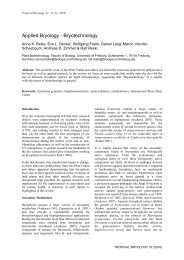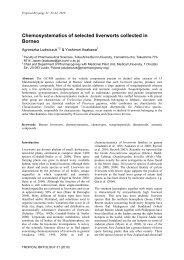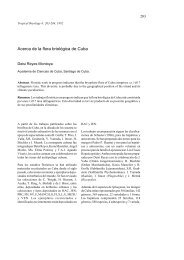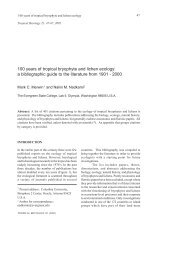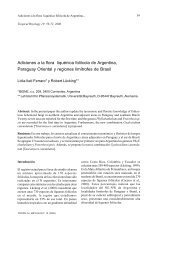Tropical component of the Moss Flora of China
Tropical component of the Moss Flora of China
Tropical component of the Moss Flora of China
Create successful ePaper yourself
Turn your PDF publications into a flip-book with our unique Google optimized e-Paper software.
218<br />
Phytogeography <strong>of</strong> <strong>the</strong> <strong>Moss</strong>es <strong>of</strong><br />
Formosa. He noted that 'The flora is largely<br />
a combination <strong>of</strong> eastern Asiatic,<br />
Himalayan and Indomalaysian types...'<br />
He fur<strong>the</strong>r pointed out that <strong>the</strong> flora “...is<br />
much more strongly Sino- Japanese than<br />
Himalayan or Indomalayan in affinity.”<br />
Many <strong>of</strong> <strong>the</strong> mosses <strong>of</strong> <strong>the</strong> tropics <strong>of</strong> <strong>China</strong><br />
have ranges extending to subtropical<br />
vegetation <strong>of</strong> nor<strong>the</strong>rn Yunnan, Guizhow,<br />
Hunan, Guangxi, Guangdong, Fujian,<br />
Taiwan, Xizhang, and Sichuan.<br />
Representative <strong>of</strong> such taxa are Garkea<br />
flexuosa (Figure 3), Octoblepharum albidum<br />
(Figure 4), Calymperes erosum<br />
(Figure 5), Aerobryidium filamentosum<br />
(Figure 6), Barbella cubensis (Figure 7),<br />
Acroporium oxysporum (Figure 8),<br />
Meteoriopsis reclinata (Figure 9),<br />
Zygodon obtusifolius (Figure 10) and<br />
Pseudoleskeopsis zippelii (Figure 11).<br />
Likewise, many species, such as Bro<strong>the</strong>ra<br />
leana (Figure 12), with an Asian and<br />
North American distribution, extend into<br />
<strong>the</strong> Chinese tropics.<br />
In summary, in spite <strong>of</strong> <strong>the</strong> incompleteness<br />
<strong>of</strong> our knowledge <strong>of</strong> <strong>the</strong> tropical moss<br />
flora <strong>of</strong> <strong>China</strong>, I strongly expect that as this<br />
flora becomes better known, <strong>the</strong><br />
geographical affinities indicated by this<br />
analysis will be streng<strong>the</strong>ned. That is, <strong>the</strong><br />
affinities <strong>of</strong> <strong>the</strong> moss flora <strong>of</strong> tropical<br />
regions in <strong>China</strong> are largely associated<br />
with Eastern Asia, India-Himalayan, and<br />
Indomalayan. Species found in <strong>the</strong><br />
Australian area may be <strong>the</strong> result <strong>of</strong> long<br />
range dispersal or, in some cases, be due to<br />
rafting <strong>of</strong> taxa on <strong>the</strong> Indian plate from<br />
Gonwanna to Laurasia. Certainly longrange<br />
dispersal is responsible for affinities<br />
with Pacific Oceanic islands. Arcto-tertiary<br />
elements in <strong>the</strong> tropical moss flora are<br />
probably related to migration patterns<br />
established during <strong>the</strong> Pleistocene<br />
(Schuster 1983).<br />
Prospects for future bryological work<br />
in <strong>the</strong> Chinese tropics<br />
Establishing a research programs in <strong>China</strong><br />
is never easy. Many negotiations need to<br />
be made with <strong>the</strong> specific persons you<br />
want to work with in <strong>China</strong>, and <strong>the</strong>y in<br />
turn have to negotiate with Provincial and<br />
County <strong>of</strong>ficials for permission to collect.<br />
Many areas are still not open to foreigners.<br />
Once one has gained permission to collect<br />
in an area travel is not particularly difficult.<br />
Four-wheel vehicles are available through<br />
most <strong>of</strong> <strong>China</strong>. However, you will<br />
sometimes wonder if <strong>the</strong>y do not have<br />
<strong>the</strong>ir frames welded to <strong>the</strong> axils. Lodging<br />
and food is no problem if you like or at<br />
least can tolerate Chinese food and hard<br />
beds. As in o<strong>the</strong>r tropical areas it is wise to<br />
take anti-malarial medication before<br />
entering <strong>China</strong>. In sou<strong>the</strong>rn <strong>China</strong><br />
schistosomiasis in present and <strong>the</strong> vectors<br />
are found in <strong>the</strong> rice paddies. Leeches are<br />
a constant problem in <strong>the</strong> tropical and<br />
subtropical regions so one must wear<br />
appropriate clothing. I find that <strong>the</strong>y are<br />
more a nuisance than a real danger.<br />
There is no region in <strong>China</strong> that does not<br />
need more field studies. Certainly <strong>the</strong><br />
tropical and subtropical regions <strong>of</strong> <strong>the</strong><br />
sou<strong>the</strong>rn provinces <strong>of</strong> Yunnan, Guangxi,<br />
Guizhow, Guangdong, Hainan, and<br />
sou<strong>the</strong>rn Xizang need much more careful<br />
investigation. In order to efficiently arrange<br />
for field work one must have a contact or<br />
contacts within <strong>the</strong> established research<br />
institutes in <strong>China</strong> such as <strong>the</strong> South <strong>China</strong><br />
Institute <strong>of</strong> Botany in Guangzhou<br />
(Canton), <strong>the</strong> Institute <strong>of</strong> Botany in Beijing,<br />
or <strong>the</strong> Institute <strong>of</strong> Botany in Kunming. All<br />
<strong>the</strong>se Institutes are part <strong>of</strong> <strong>the</strong> Chinese<br />
Academy <strong>of</strong> Sciences (Academia Sinica).<br />
One <strong>of</strong> <strong>the</strong> most promising ways to gain a<br />
better understanding <strong>of</strong> <strong>the</strong> bry<strong>of</strong>lora <strong>of</strong><br />
<strong>China</strong> is through extended visits <strong>of</strong> Chinese<br />
bryologists and <strong>the</strong>ir students to western<br />
Universities and research institutions.<br />
When <strong>the</strong>y return, to <strong>China</strong> <strong>the</strong>y not only<br />
provide us with established contacts in




